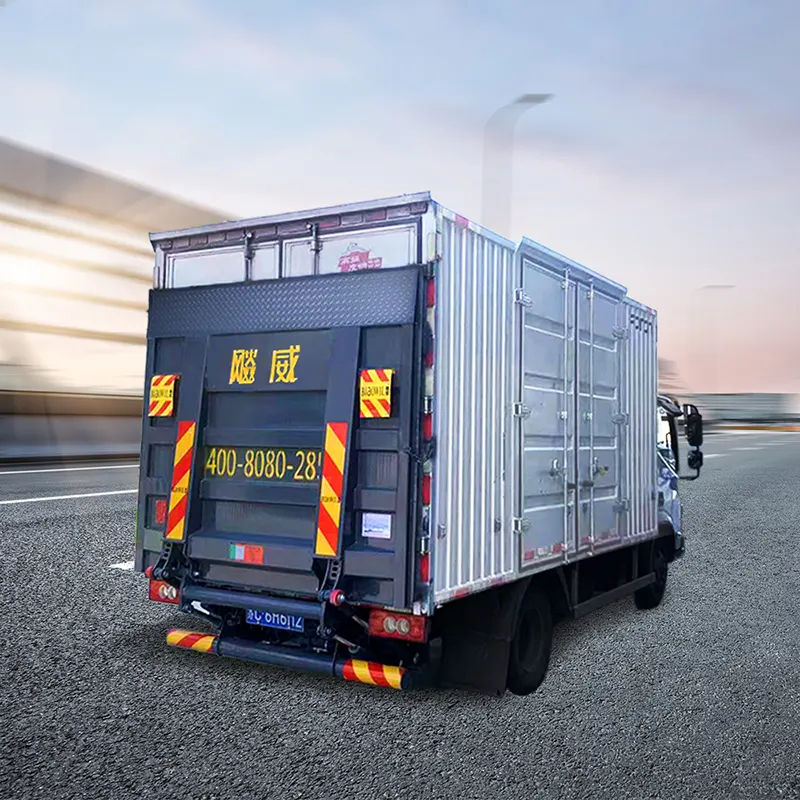Comment fonctionne un lifting de queue?
Anhui-Beauway-machinery-manufacturing-co-ltd-launches-new-tail-lift-products-to-greatly-improve-the-loading-and-unloading-efficiency-of-trucks-trucks-and-logistics-vehicles
A tail lift is a mechanical device attached to the rear of a truck or van, Conçu pour soulever et abaisser les marchandises entre le sol et le lit de chargement du véhicule. Voici une explication du fonctionnement d'un ascenseur de queue, pas à pas:
Key Components of a Tail Lift
- Hydraulic or Pneumatic System: The main mechanism that powers the lifting and lowering of the platform. Most tail lifts use hydraulics, though some may use pneumatic systems.
- Control Unit: A set of controls (usually buttons or levers) that allow the operator to raise, lower, or tilt the platform as needed.
- Lifting Platform: A flat surface that holds the load during lifting or lowering.
- Lifting Arms or Rails: These connect the platform to the vehicle and provide stability during operation.
- Power Source: The lift typically draws power from the vehicle’s electrical system, often using a battery or alternator to operate the hydraulic pump.
- Safety Mechanisms: These include features like limit switches, pressure relief valves, and overload protection to prevent accidents or equipment failure.
How a Tail Lift Works: Step-by-Step Process
- Deploying the Tail Lift:
Start-Up: The operator activates the tail lift via the control panel, usually located near the rear of the vehicle.
Unfolding the Platform: In types like the tuckaway or slider lifts, the platform is folded under the vehicle. The operator unfolds the platform and positions it flat, ready to load. - Loading the Platform:
Once the platform is fully deployed and positioned at ground level, the operator loads the cargo onto the lift. This can be done manually or with a pallet jack for heavy goods.
The platform can usually handle significant weight, but it has a maximum capacity (often ranging from 500 kg to several tons, depending on the model). - Lifting the Load:
The operator presses the “up” control, activating the hydraulic or pneumatic system. The hydraulic pump forces fluid into the lifting cylinders, which extend the lifting arms or rails, causing the platform to rise.
The platform ascends smoothly to the level of the truck bed. The lift is designed to maintain a stable, level position during the entire process. - Unloading into the Vehicle:
Once the platform reaches the height of the cargo bed, the operator transfers the load into the truck or van.
The platform often has safety features like side rails or anti-slip surfaces to prevent cargo from shifting or falling off. - Lowering the Platform:
After unloading, the operator presses the “down” control. This releases hydraulic pressure, allowing the fluid to flow back into the reservoir and the lift to descend smoothly.
The platform returns to the ground, ready for the next load or to be stowed away. - Stowing the Tail Lift:
Once all loading or unloading is complete, the platform is folded back into its storage position (for tuckaway or slider models) or simply retracted (for cantilever and column lifts).
The operator secures the tail lift in place, ensuring that it won’t move during transport.
Safety Features and Considerations
Limit Switches: These prevent the platform from raising too high or descending too low, protecting both the equipment and the operator.
Overload Protection: If the load exceeds the lift’s rated capacity, the system will not operate, preventing potential damage or accidents.
Pressure Relief Valve: This prevents hydraulic pressure from exceeding safe limits, which could otherwise cause mechanical failure.
Tilting Mechanism: Some tail lifts (like cantilever types) have a tilt function to make it easier to load or unload on uneven surfaces.
Common Applications
Delivery Vehicles: For moving goods in and out of trucks, especially in urban environments where loading docks may not be available.
Construction and Industrial Use: Transporting heavy equipment or materials.
Moving and Relocation: For handling heavy furniture, appliances, or other large objects.
En résumé, a tail lift provides a smooth, mechanical solution for loading and unloading heavy goods, making it much easier and safer to handle large items, especially where manual lifting would be difficult or dangerous.
